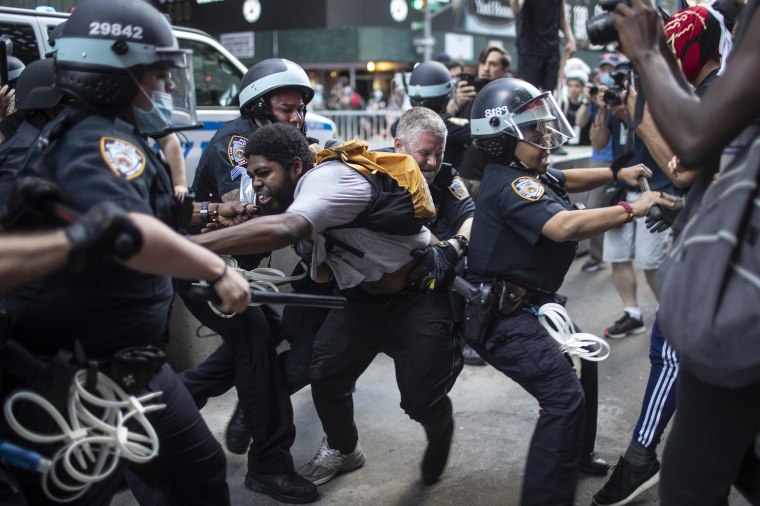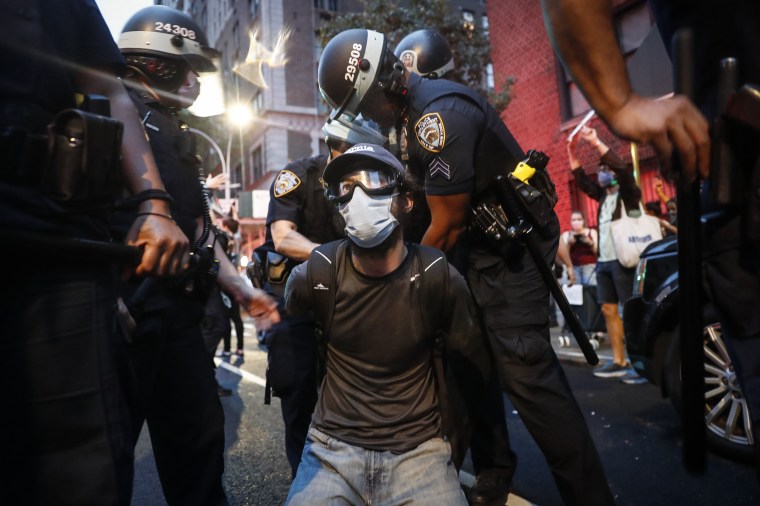A Minneapolis judge ordered the city’s police department to stop using neck restraints and chokeholds. A majority on the City Council pledged to dismantle the department, and the chief withdrew from contract negotiations with the police union to allow for "greater community transparency."
These are some of the steps taken in Minneapolis following more than two weeks of demonstrations in cities around the world to protest the killing of George Floyd while in police custody.
But activists, reform advocates and even those who work in law enforcement question whether these types of changes, not only in Minneapolis but also in other cities in the United States, are enough to heal widespread distrust between communities of color and police departments.
“Banning neck restraints does not address the structural problems in the police department and does not address the cultural problem that we have about devaluing black folks,” Mike Griffin, a Minneapolis activist, said. He added that greater systemwide reforms must be made to bring about lasting change and improve the lives of black people in his city.

“We will be in this same exact moment in three months, in six months, in a year from now unless we change the significant structural problems of not only the police department, but the racial gaps we have in the city,” Griffin, an electoral organizer for Community Change, said.
On the same day Minneapolis banned the restraints, California Gov. Gavin Newsom ordered the state’s police training program to stop teaching officers how to use any neck hold that blocks the flow of blood to the brain.
New York and Florida, the cities of Denver and Phoenix, plus France have all also banned neck restraints in the wake of Floyd’s death.
On Monday, House Speaker Nancy Pelosi, D-Calif., and other top Democrats in the House and the Senate unveiled the “Justice in Policing Act” that would ban chokeholds across all police departments. It would also require local police departments to send data on the use of force to the federal government and create a grant program that would allow state attorneys general to create an independent process to investigate misconduct or excessive use of force.
The next day, Houston Mayor Sylvester Turner took a moment from addressing Floyd’s loved ones during the 46-year-old’s funeral service to announce he would sign an executive order banning chokeholds and strangleholds.
“In this city, we will require de-escalation,” Turner said. “In this city, you have to give a warning before you shoot. In this city, you have a duty to intervene. In this city, we will require comprehensive reporting. In this city, you must exhaust all alternatives before shooting.”
He added that any reforms must go “beyond just policing.”
“When we invest in communities that have been underserved and underinvested in … then you don’t have to spend as much on policing,” Turner said.
The refrain is echoed among people who work in law enforcement or have closely watched its evolution over the decades. Even before agencies announced sweeping changes, many police and National Guard members were spotted attempting to de-escalate heated protests by kneeling with demonstrators or dancing with protesters.
But how to ensure rank-and-file officers won’t commit acts of brutality when faced with stress and trauma remains a puzzle few departments have solved.
“We’re past metaphors,” Patrick Skinner, a former CIA operations officer, told MSNBC, adding that the problem goes beyond training and straight to the heart of police culture.
“Our nation needs to change the mindset of what it means to be a police officer,” he said. “We’re cops. We’re not warriors ... If you have a warrior mindset, you can’t de-escalate.”
Skinner, who now trains police in Savannah, Georgia, says he likes to role-play when working with new officers.
“I always say, ‘If you didn’t have a badge and a gun, how would you handle this 911 call?’ If whatever you come up with is thoughtful, legal and kind, try that first,” he said.
The tension between having a warrior or a neighbor mentality is playing out in the Los Angeles Police Department, which has a long history of overpolicing communities of color.
Mayor Eric Garcetti said last week he would not authorize a budget increase for the department and would instead reallocate $250 million from the city's proposed 2020-21 budget to black communities to help address health and education issues.
He also temporarily prohibited officers from entering the names of suspected gang members into a statewide database, a sticking point for reform advocates who say it unfairly targets men of color.
Los Angeles Police Commissioner Shane Goldsmith, who is also president and CEO of Liberty Hill Foundation, a social change organization, wants officers to work more closely with the communities they serve.
“Public safety is not just about the police,” she said. “In many cases, police don’t make people feel safe and they don’t make them safe.”
True safety comes from communities brimming with educational and employment opportunities and enough resources to help residents who might be struggling, she said.
“We need real transformation,” she said. “It’s about culture change. It’s about who we hire and how we train them and identify all the ways that racism gets perpetuated and embedded."
In Minneapolis, activist John Thompson said many of these reforms should have been put in place after his friend and co-worker Philando Castile was fatally shot in 2016 by Jeronimo Yanez, a police officer in the Minneapolis suburb of St. Anthony.
“George Floyd didn’t have to die for us to be having this conversation about reform," Thompson, founder of the group Fight for Justice Enterprises, said. “What we’re doing now is reactive, as opposed to proactive.”
Thompson noted that members of the Minneapolis City Council who say they want to dismantle the police department have not explained what that means or offered any details.
“I would love to entertain that conversation and be a part of that conversation and would love to see some alternatives to modern-day policing, but if we don’t have a plan, then we’re just acting out of anger,” he said.
Arianna Nason, a member of the activist coalition MPD150 Collective, said Minneapolis "is making history by beginning the community-driven process to dismantle the police department.”
“This is completely uncharted territory, so it is not entirely unreasonable that there is not a lot of clarity in terms of hard policy out there available,” she said. “I guarantee you that it will be coming out in the coming weeks as we have teams working on that.”
“It absolutely needs to be a community driven, community led process,” she said. “That being said, defund the police -- that is the absolute necessary first step, to remove the massive amount of funding that the Minneapolis Police Department has been designated.
“That money needs to be immediately reinvested into communities most affected by police violence.”
The New Jersey city of Camden experimented with this concept in 2013 when it disbanded the police department, tore up union contracts and introduced a countywide approach that focused on community patrols. Camden police officers are now seen as “guardians, not warriors,” Camden County Freeholder Director Louis Cappelli Jr. told NBC New York.
But by replacing city police with county police, Camden officers don’t necessarily reflect the black and the brown residents who are more likely to live in the city than around it. This issue continues to play out in departments across the country.
“I want to make sure we keep our eye on the ball on what can actually make black lives better,” Griffin, the Minneapolis activist, said.
He said changes, including reducing the police union's power and divesting money from the department into community services, must happen swiftly to save black lives.
“They’re gambling with my life," he said. "We need this very quickly, because every day that goes by puts black people’s lives in danger.
“Who else needs to die? As we’re trying to figure this out, I could be next.”


